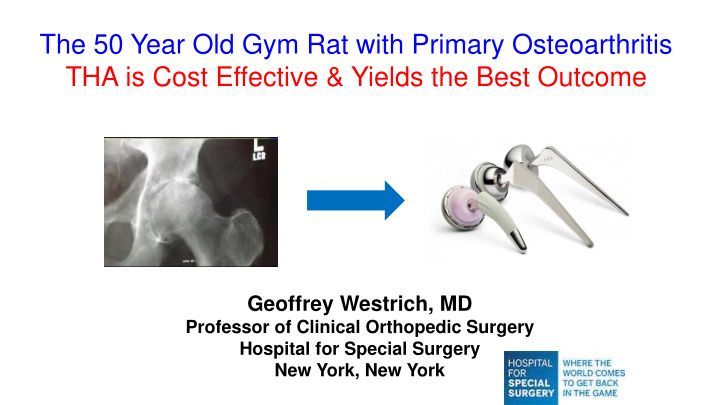



The 50 Year Old Gym Rat with Primary Osteoarthritis THA is Cost Effective & Yields the Best Outcome Geoffrey Westrich, MD Professor of Clinical Orthopedic Surgery Hospital for Special Surgery New York, New York
The 50 Year Old Gym Rat with Primary Osteoarthritis • Surgical Options • Hip Arthroscopy? • Osteotomy? • Fusion? • Hip Resurfacing? • Total Hip Replacement?
Hip Arthroscopy - High failure rate in the setting of osteoarthritis • Failed hip arthroscopy (persistent pain or eventual THR) has been attributed to incorrect preoperative diagnosis & poor patient selection. • Kim et al reported that arthroscopic intervention for early-stage osteoarthritis in the presence of femoroacetabular impingement is associated with poor clinical results because of a failure to alleviate symptoms of osteoarthritis. • Philippon: “…failure in diffuse osteoarthritis”
Hip Osteotomy - High Failure Rate in the Setting of Osteoarthritis • Osteotomy is a good alternative ONLY if the patient is young and arthritis is in a small area of hip joint. Arthritic bone is rotated away from hip joint, placing weight bearing on uninvolved portions of the ball and socket • Varus or varus femoral osteotomy or pelvic osteotomy not appropriate in this patient with diffuse OA • Periacetabular Osteotomy for Acetabular Dysplasia in Patients Older than 40 Years: A Preliminary Study • “PAO will give satisfactory functional and pain scores in patients over age 40 having dysplastic hips with mild or no arthrosis.” (Millis 2009)
Hip Fusion – Really? • Obvious why this is a poor choice • No one wants their hip fused!
Hip Resurfacing • Historically considered “bone preserving” • Bearing surface metal-on-metal (cobalt chromium) • Very sensitive to edge loading and poor positioning • Risk of ALTR and femoral neck fracture • Fallen out of favor
Hip Replacement – Of Course! • THR is the BEST option for 50 year old patient with advanced osteoarthritis • Bearing surface options: • Ceramic on Ceramic • Ceramic on Polyethylene • Dual Mobility with Ceramic on Poly
Hip Replacement Considerations • Regional Anesthesia (IV sedation and spinal) • Posterolateral or Anterior Approach • Multimodal Pain Management • Periarticular Injection • Physical Therapy Immediately • Reinforce Hip Precautions and Avoiding Impact • Set proper expectations PREOPERATIVELY
Wear Analysis of Highly Cross-Linked Polyethylene in Young and Active Patients at Average 14 years. J Arthroplasty 2017, Ranawat • 57 hips (mean age 53 yo) 28 mm heads with 1 st generation HXLPE • Mean 14 year follow up • Metal head on 1 st generation HXLPE: wear rate of 0.03 mm/year • Excellent wear and clinical results at 10 to 17 years in young active patients • Survivorship 100% and no osteolysis.
Wear Rates With Large Metal and Ceramic Heads on 2 nd Generation Highly Crosslinked Polyethylene at Mean 6 Year Follow-Up. J Arthroplasty 2017, Ranawat • 60 patients with non-cemented THR and 32 or 36 mm ceramic heads on polyethylene matched to 60 patients with similar metal heads • Mean 6 year follow up • Metal on poly wear rate was 0.018 mm/year • Ceramic on poly wear rate was 0.012 mm/year (0.06 mm/50 years!) • Authors recommend ceramic on poly to avoid trunnionosis with metal heads.
Hard-on-Hard Bearings Are Associated With Increased Noise Generation in Young Patients Undergoing Hip Arthroplasty. Clin Orthop 2016, Nam and Barrack • Overall 9% of young patients undergoing THA reported noise generation. • Females 12% have increased likelihood of noise versus males 7% • Ceramic-on-ceramic or metal-on-metal: 14% increased grinding, popping, and clicking versus 3% with a polyethylene liner with a ceramic, oxidized zirconium, or cobalt-chromium femoral head • Noise generation associated with increased pain and stiffness after THA.
Cost-effectiveness of timely vs delayed primary THR in Germany. 2017 • Evaluated costs and health benefits of timely primary THR • Compared to nonsurgical treatment and then THR and nonsurgical treatment alone • Evaluated health outcomes and QALY • Timely THR is cost-effective, generating large quality of life benefits at low additional cost to the health care system
Dual Mobility: • 0% Dislocation Fixed Bearing • 5.1% Dislocation • 5/7 Cups In Lewinnek Safe Zone
Sensitivity analysis: Worst case scenario if all DM dislocations required surgery: STILL COST EFFECTIVE!
Conclusions The 50 year old gym rat with primary osteoarthritis is best served with a THR THA is cost effective & yields the best outcome
Thank you
Recommend
More recommend